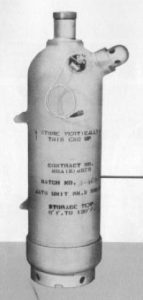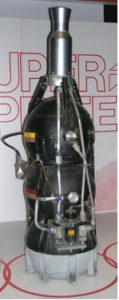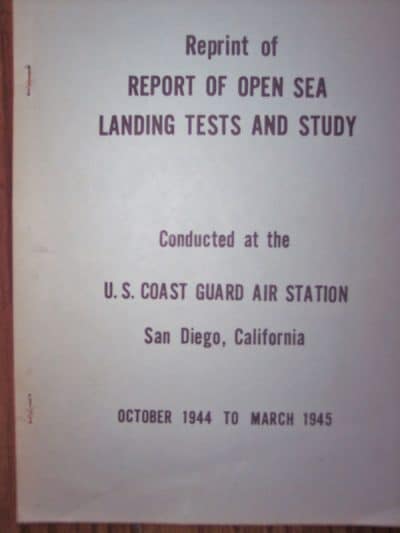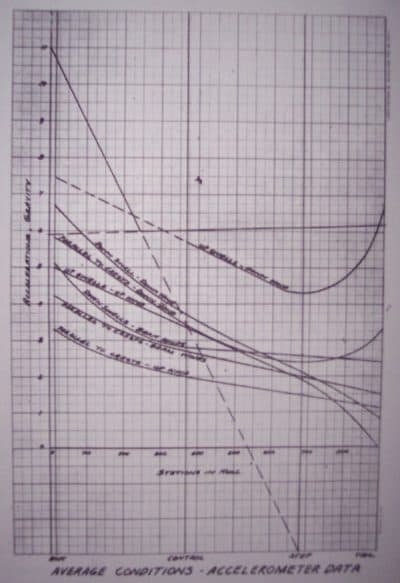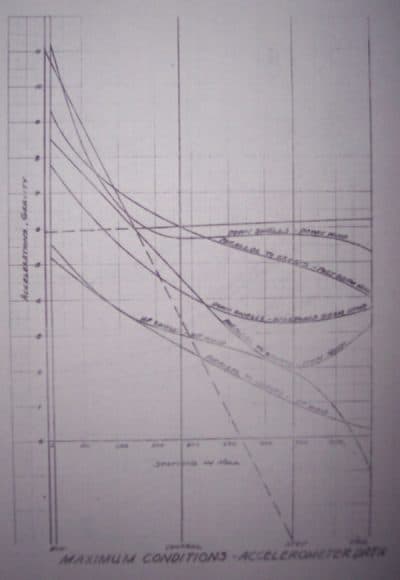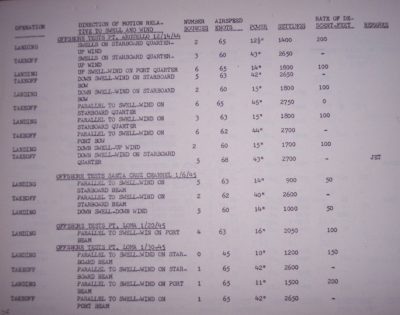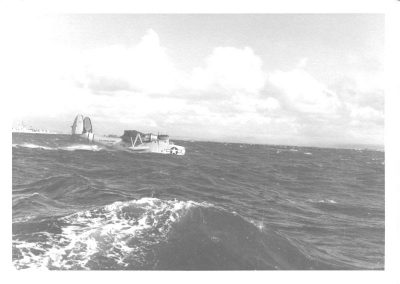SEAPLANES AND OFFSHORE OPERATIONS
by Captain Robert B. Workman, Jr. USCG (Ret.)
Of many milestones occurring in naval aviation from mid 1940 through the 1950s, four determined the future of seaplane operations offshore: 1.) Large seaplane open sea landing and takeoff procedures were advanced to their zenith; 2.) Jet Assisted Takeoff (JATO) was born; 3.) Helicopters with adequate endurance and power were advancing; and, 4.) The last Coast Guard large seaplanes were retired in 1960 ending an era.
In 1910, Glenn Curtiss dramatically launched a 40 HP Pusher propeller landplane, flown by Eugene Ely , from a crude sloping wood platform on the bow of light cruiser USS Birmingham (CL-2). Even so, Congress shunned authorizing aircraft carrier development. A large ship meeting the WWI Bureau of Aeronautics (BUAERO) specification for 45 knots cruising speed was considered too expensive. 45 knots was the minimum required to launch and recover aircraft. Therefore, Naval Aviation’s aircraft development was restricted to battleship and cruiser catapulted floatplanes and flying-boats until commissioning of USS Langley (CV-1) on March 20, 1922. During the years leading to the World War, Coast Guard aviators participated in Naval Aviation development, testing and aviation equipment programs. After the war, Navy and Coast Guard mission sets diverged with the Navy converging on aircraft carrier and landplane development. The Coast Guard continued to advance flying-boats and seaplanes for its offshore Title 14 US Code assigned missions of Treaty and Law Enforcement and Search and Rescue. During the final years of WWII the newly invented helicopter lacked power and range beyond 70 miles offshore; seaplanes were still required until arrival of Sikorsky turbine HH52A helicopter in early 1960s.
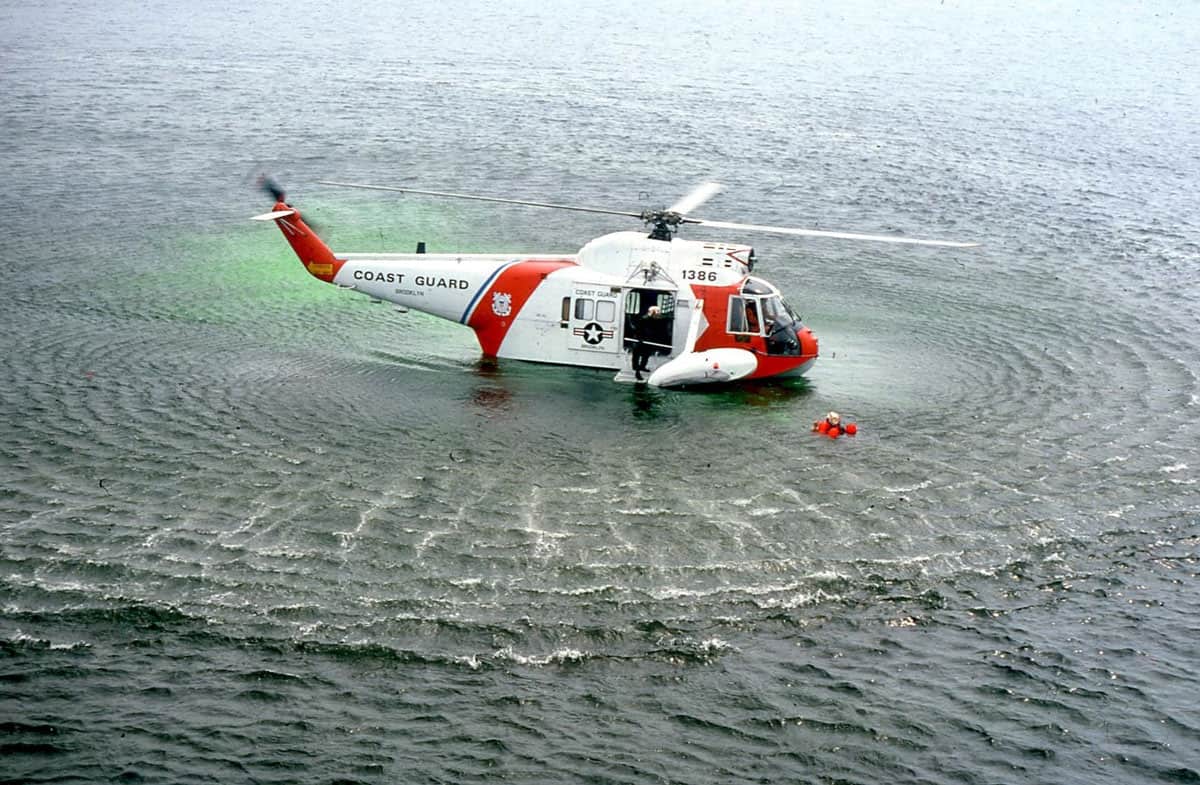
During both world wars the British, Germans, and later Pan American Airlines (with its large clipper passenger seaplanes) developed procedures for rough water takeoffs and landings. Following the First World War, the Coast Guard developed and published open-sea landing and rescue procedures. These early rough water techniques were to touch down on the backside of the primary swell in a nose high power off full stall attitude. The pilot held his yoke all the way back, holding wings level and nose eight to twelve degrees up until the seaplane came off the step and the nose dropped to a level attitude. While acceptable in light seas, it was risky in rougher water. Using this procedure, the pilot was committed to land and should the seaplane be thrown back in the air by a swell with its nose high and below stall speed, adding throttle only made subsequent bounces higher and following touchdowns harder than the previous ones. This dynamic porpoising flight combined with torque from the propellers could cause serious aircraft damage.
The Coast Guard was transferred by Executive Order to the Navy in World War II. Commander Donald B. MacDiarmid U.S. Coast Guard, Naval Aviator, and oceanographer, was commanding officer of Coast Guard Air Station (CGAS) San Diego, California. Based on his offshore operational experience and knowledge of ocean conditions, he was convinced existing procedures could be improved so that offshore seaplane operations could be performed within acceptable risk. MacDiarmid requested authority from the Chief of Naval Operations (CNO) in 1944 to conduct open sea landing tests with a Navy PBM-3 seaplane to determine the best way to land a seaplane or to ditch a fixed wing landplane in the open sea.
Also around 1944, a WWII research effort was progressing in China Lake to develop a rocket propelled assist for heavy bomber takeoffs. Unrelated to China Lake, but sharing ideas and support, Doctor Robert H. Goddard was developing ideas for heavy lift seaplane Jet Assisted Takeoff (JATO) missions and for surveillance aircraft launch-assist using catapults for the Navy in his Annapolis laboratory. His contract funding for a Navy seaplane test crew had intermittent support from the Navy. Even though the Navy JATO program was very supportive of MacDiarmid’s offshore tests, developing JATO was not part of MacDiarmid’s test program. MacDiarmid’s request to conduct open sea landing tests seemed to be a good fit with Doctor Goddard’s seaplane JATO development effort. These events brought support to MacDiarmid’s offshore test program from the Navy JATO contract with the California Institute of Technology (CalTech) and its scientists, including noted astronomer Fritz Zwicky, and his fledgling Aerojet Company.
MacDiarmid’s request for loan of Navy Martin PBM-3 6586 was approved by CNO letter dated July 30, 1944. Action also was initiated to take possession of Dr. Goddard’s JATO systems and trained personnel. These support technicians established and helped to accomplish an instrument recording plan, to obtain and calibrate instruments, to make analyses of instrument stress records indicating excessive stresses on the aircraft. They also provided services of photographers and proper photographic equipment and film and processing facilities, and capabilities to accurately determine actual wind and sea conditions during test flights. It was determined tests would be based upon records of oscillographs with sensors in the bow, center of gravity, tail, points located on the fuselage chine, and in the wing. Instrument records would not only determine the stresses and strains on the seaplane, but would measure the oscillations and vibrations, and their frequency nodes on the seaplane during landings and takeoffs. The instrument plan called for four National Advisory Committee for Aeronautics (NACA)-two-component accelerometers and one Hathaway landing analyzer to be installed at the seaplane’s center of gravity.
The Martin Aircraft Company sent two technicians to the Coast Guard air station to install the sensor instruments at the seaplane’s stress points on the wings and hull as the seaplane would take pounding on various headings and sea conditions during landings and takeoffs. Accelerometers were installed in the bow, center of gravity, step, and tail of the seaplane. An anemometer on board the test site photographer’s boat accurately recorded wind direction and velocity, and The Institute of Oceanography at La Jolla made regular measurements and recordings of swell conditions. Seaplane flight tests commenced November 17.
Aviation Chief Ordananceman Arnie (Ackack) Adams, the air station ordnance department chief, was MacDiarmid’s liaison with the Navy JATO project and implemented it within MacDiarmid’s test operations. JATO information in this article was provided by Adams. He was part of this historical story.
The Aerojet JATO rocket system delivered to CGAS San Diego was a highly specialized, self-contained rocket motor experimental unit that could support invasion of Pacific islands during the war. It was a workshop equipped with a large diesel-driven generator and compressors using exhaust to generate an inert gas under high pressure. Rail cars delivered stainless steel sealed drums of rocket fuel to the Consolidated Aircraft Company adjacent to the Coast Guard Air Station. The German’s called this fuel Stof N and O.
The rocket motor was a GALCIT1400 ALDW (Guggenheim Aeronautical Laboratory Caltech 1400 pounds of thrust Air Launch Droppable fuel system). Instead of compressors, it used pressurized gas to push liquid fuel through a spray nozzle to the firing chamber. The fuel was a self-igniting monoethylanine and a mix of hydro-sulfuric and nitric acid as oxidizer.
The attached GALCIT1400 ALDW liquid-motors functioned well in sheltered waters; however, when MacDiarmid began his offshore tests in rough waters, fuselage attachment-point failures arose. On one test-flight-takeoff, the right wing motor tore from its attachment point and acid burned into the seaplane’s aluminum structure. The GALCIT1400 ALDW was removed from Commander’s MacDiarmid’s test program and diverted to rocket development for the Northrop flying wing and the P51 fighter response to the Messerschmitt 163E programs. The Navy selected a solid propellant program as support for Captain MacDiarmid’s tests.
Due to the war’s restrictions on materials, the solid JATO motor and propellant development was kluged together with steel oil-well-pipe drilling-casings capped on one end and fitted with a threaded nozzle and igniter on the other end. The JATO rocket propellant was a mixture of potassium-perchlorate and a tar-like goop poured into production molds to harden, then removed and wrapped in duct-tape to hold shape and prevent cracking for an even burn. The solid propellant was then inserted into the oil-pipe casing. The JATO unit was nicknamed “Old Smokey” since it spewed a large volume of smoke when burning correctly.
In addition to open sea landing tests, CGAS San Diego ordnance men and parachute riggers were tasked to research and improve naval service survival equipment and their loading and delivery to ditched aircrews and survivors.
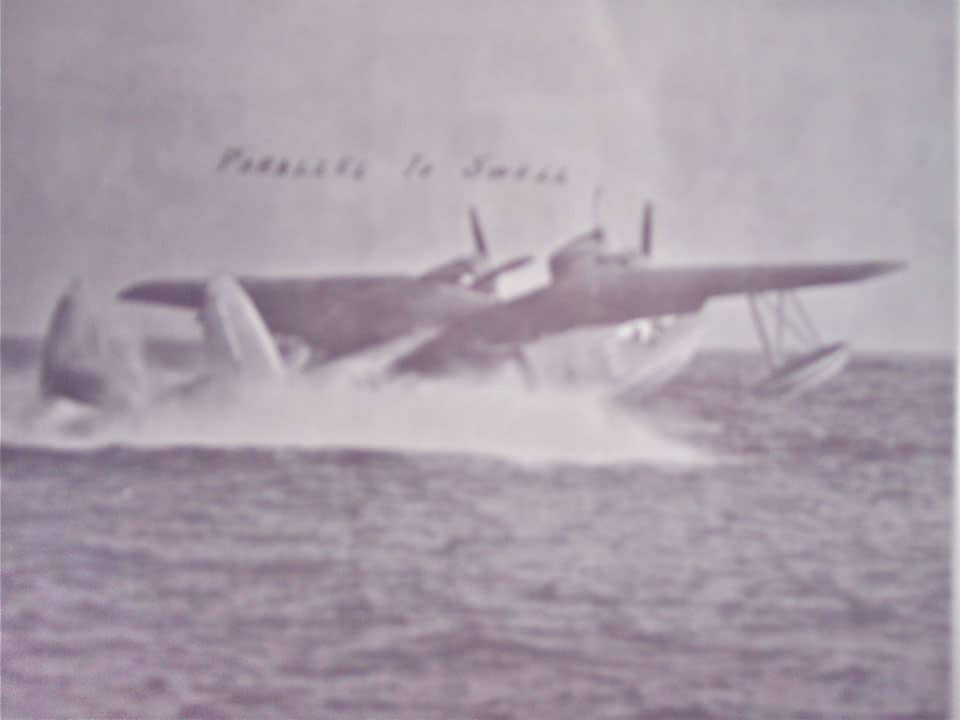
MacDiarmid assigned his favorite duty pilot, Chief Aviation Pilot John Vuckic, USCG (nicknamed “The Greek”) to work with him to establish the Open Sea Landing test Program. Three to four air station duty pilots were assigned on a voluntary basis to each seaplane test flight to fly and record a wide range of reactions. Some had never made an offshore landing before.
Objectives and scope for the tests and study were formalized for an answer in a report to CNO, to Commandant of the Coast Guard, and to the Martin Aircraft Company. Tests were to make landings and takeoffs in the open sea under progressively more severe conditions to determine:
1. What heading with respect to the sea, Pacific swell and the wind is best for landings and takeoffs.
2. What characteristics or qualities of various conditions of sea and wind constitute special hazards to aircraft landing or takeoff.
3. What are the best pilot qualities and techniques for successful open sea landings and takeoffs in varying sea and wind states?
4. What merit does the PBM-3 airplane have as a rescue plane for this type of work?
5. What special weaknesses does the PBM-3 aircraft exhibit in this work and then analyze and recommend specific alterations to cure them?
6. By careful analysis of recorded data, what stresses on the aircraft during open sea operations in various conditions indicate hazards of structural failure not previously known or understood.
7. What advantages and disadvantages are encountered in carrying and using JATO gear for rough water landings and takeoffs.”
Before any test flights were made, MacDiarmid would give all his duty pilots instruction on oceanography pointing out the large swells systems coming out of the Aleutians and those rolling in from the southwest from a low pressure area off Hawaii. Weather forecasts were studied for swells they would send. Pilots then flew offshore at 1,500 feet to observe and study effects of swell systems traveling through each other, and to measure the height, distance between, and period of each swell system. Swell speed was derived from the formula S = 3.03P where S equals swell speed in knots and P equals the period, or time, in seconds between passing swells. An air station crash boat stood by in the test area with a swell-height-measurement gauge. Local wind conditions formed waves that superimposed on both swell systems without influencing their pattern. Occasionally, due to the difference in swell speed and direction, a swell would partially fill the trough between two crests forming a relatively smooth landing area. Prior to conducting each test flight, a full description of weather and sea conditions was recorded.
Test flights were flown with MacDiarmid in the copilot’s seat, one duty pilot in the pilot’s seat and the other two or three duty pilots were back in the waist to record data. Landings and takeoffs were made in all directions around the compass rose disregarding the wind unless it exceeded 20 knots. Pilot flight technique instruction from MacDiarmid and data recording took place while the seaplane ricocheted, pounded, and skipped across trough and crest as MacDiarmid calmly smoked and chewed his cigar as if reading a newspaper on a Sunday morning. In the seaplane’s waist, the crew held on with white knuckles up to the elbow. After each pilot completed his series of landings and takeoffs, he would rotate with a duty pilot in the waist. Duty pilots gained a respect for what the crew was subjected to. Modern day flight crews should appreciate that in those days there were no crash helmets and only the cockpit pilot, navigator, engineer, and radioman seats had shoulder harnesses. Some landings were made in eighteen-foot high swells with a swell’s speed of 48.5 knots.
When the wind was below 20 knots, regardless of the wind direction, the best landing or ditching procedure was found to be parallel to the primary swell and touchdown in the direction that the secondary swells traveled. The next favorable procedure found was to land in the direction the primary swell traveled and parallel to the secondary swell. When the wind was above 20 knots, the only choice was to land within a forty-degree arc centered on the wind direction. The aircraft would be headed directly into the wind until just before touchdown, and then turned using the rudder to the touchdown heading. Landing directly into any swell was high risk and avoided. The aircraft then was leveled off flying just above stall speed (110% above power-on stall speed) until a relatively smooth spot was found. Power was then reduced only enough for touchdown. Should the sea conditions be too great for landing, gradual power was then applied for a missed approach departure.
Meticulous collection and recording of data were made before, during and after each test flight. The following illustrations are but a small sample of many taken from MacDiarmid’s report to CNO, Commandant, U.S. Coast Guard, and the Martin Aircraft Company.
CGAS San Diego reprinted MacDiarmid’s REPORT OF OPEN SEA LANDING TESTS AND STUDY, OCTOBER 1944 – MARCH 1945 on December 20, 1957 for air station duty seaplane pilots to study and hone their seaplane techniques. The introduction stated: “Although this report was prepared approximately twelve years ago, the principles of open sea operation of large seaplanes set forth in it have borne the test of time and are still considered valid.”
MacDiarmid was promoted to Captain. In 1950, at an Institute of Aeronautical Sciences dinner, MacDiarmid was presented the Chanute Octave Award by the National Advisory Committee for Aeronautics (NACA) for outstanding contributions to Air-Sea rescue technique.

Captain MacDiarmid was enshrined in the Naval Aviation Hall of Honor at the National Naval Aviation Museum in Pensacola, Florida. The doctrines established by his studies were adopted by the Coast Guard and the Navy and became part of the National Search and Rescue Manual, and later the International Civil Aviation Organization’s doctrines and procedures. He retired from service July 1, 1959, after logging over 8,000 hours pilot time and over 400 open-sea landings and takeoffs.
At the end of the program, the Navy Bureau of Aeronautics provided additional Martin PBM-3, PBM-5, PBM-5A, P5M seaplanes and a Grumman Albatross (UF-1G) amphibian for evaluating potential seaplane structural failure points.
AUTHOR’S NOTES
ROUGH SEAS AND CIGARS
Commander Mac Diarmid’s official REPORT OF OPEN SEA LANDING TESTS AND STUDY – Conducted at the U.S. Coast Guard Air Station, San Diego, California, October 1944 to March 1945.
Captain MacDiarmid official Biography.
December 12, 1952, National Advisory Committee for Aeronautics letter.
August 6, 1951, San Diego Union.
August 15, 1951, San Diego Tribune.
October 12, 1950, and November 1947 Coast Guard Magazines published by Coast Guard headquarters.
April 1993 Flight Lines, Flight Safety newsletter published by Coast Guard headquarters.
MacDiarmid memorandum: Stinton – Smith interview: “This idea of landing along the major swells was passed to Admiral Smith (Willard J. Smith) by Pan American Clipper pilots at CGAS San Francisco in 1942 – 43. Smith used this technique for 2 successful off-shore rescues in 1943.” Smith received a letter of Commendation from the Commandant of the Coast Guard for landing a PBY in the open sea 200 miles southwest of San Francisco on 13 February 1943 to remove an officer from a navy vessel to a naval hospital in time to save the patient’s life.
Coast Guard History web page.
The Coast Guard Bulletin, date unknown.
Captain Donald Bantram MacDiarmid – Aviator by Barrett T. Beard.
Captain Mac and Flying Coffins, 1995-2002 – Presented to the Port Angeles Historical Society on February 3, 2002, by Barrett T. Beard.
Naval Aviation News, November – December 1994, Cigars and Rough Water by Ken Bilderback.
JATO, THE EARLY DAYS essay by Arnie (Ackack) Adams, CHGUN W3, USCG, Retired
MacDiarmid Distinguished Fly Cross award citation.





